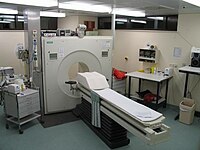
Photo from wikipedia
The accuracy of images obtained by Diffuse Optical Tomography (DOT) could be substantially increased by the newly developed time resolved (TR) cameras. These devices result in unprecedented data volumes, which… Click to show full abstract
The accuracy of images obtained by Diffuse Optical Tomography (DOT) could be substantially increased by the newly developed time resolved (TR) cameras. These devices result in unprecedented data volumes, which present a challenge to conventional image reconstruction techniques. In addition, many clinical applications require taking photons in air regions like the trachea into account, where the diffusion model fails. Image reconstruction techniques based on photon tracking are mandatory in those cases but have not been implemented so far due to computing demands. We aimed at designing an inversion algorithm which could be implemented on commercial graphics processing units (GPUs) by making use of information obtained with other imaging modalities. The method requires a segmented volume and an approximately uniform value for the reduced scattering coefficient in the volume under study. The complex photon path is reduced to a small number of partial path lengths within each segment resulting in drastically reduced memory usage and computation time. Our approach takes advantage of wavelength normalized data which renders it robust against instrumental biases and skin irregularities which is critical for realistic clinical applications. The accuracy of this method has been assessed with both simulated and experimental inhomogeneous phantoms showing good agreement with target values. The simulation study analyzed a phantom containing a tumor next to an air region. For the experimental test, a segmented cuboid phantom was illuminated by a supercontinuum laser and data were gathered by a state of the art TR camera. Reconstructions were obtained on a GPU-installed computer in less than 2 h. To our knowledge, it is the first time Monte Carlo methods have been successfully used for DOT based on TR cameras. This opens the door to applications such as accurate measurements of oxygenation in neck tumors where the presence of air regions is a problem for conventional approaches.
Journal Title: Advances in experimental medicine and biology
Year Published: 2017
Link to full text (if available)
Share on Social Media: Sign Up to like & get
recommendations!